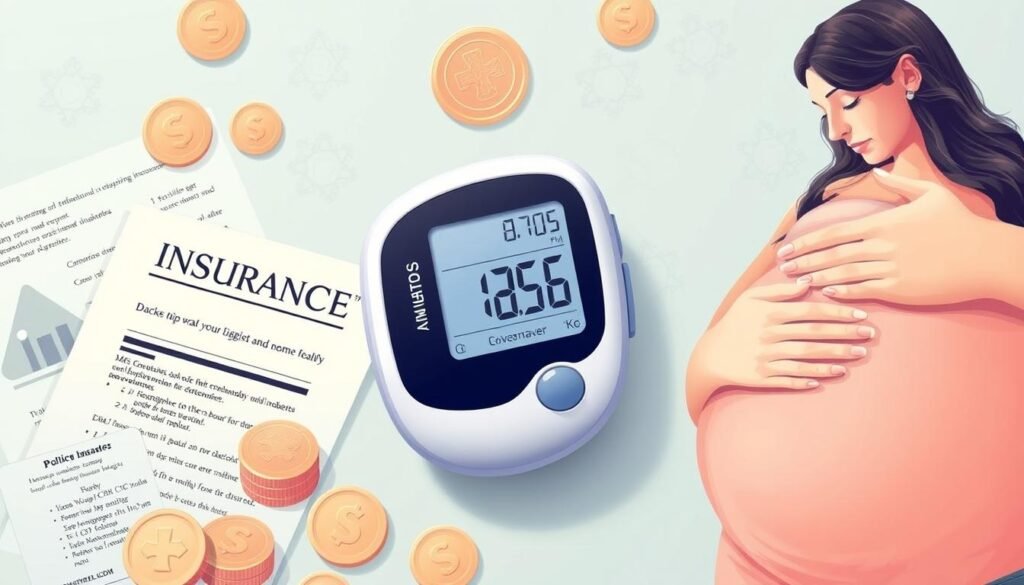CGM for Gestational Diabetes: Continuous Glucose Monitoring (CGM) is a key tool for managing gestational diabetes. It gives real-time insights into glucose levels. This helps women make better choices about their diet, exercise, and insulin therapy.
It’s important for both the mother’s and the baby’s health. Good management of gestational diabetes is essential to avoid complications and ensure a healthy pregnancy.
Gestational diabetes is common in pregnant women. Using CGM can greatly improve glucose control. With CGM technology, women can understand their glucose levels better.
They can then adjust their lifestyle and treatment plan. This leads to successful management of gestational diabetes.
Key Takeaways
- CGM provides real-time glucose level monitoring for women with gestational diabetes
- CGM for gestational diabetes helps inform decisions about diet, exercise, and insulin therapy
- Effective gestational diabetes management is crucial for a healthy pregnancy
- CGM technology offers dynamic insights into glucose levels, enabling better glucose control
- CGM for gestational diabetes is a valuable tool for managing the condition and preventing complications
Understanding CGM for Gestational Diabetes
CGM for Gestational Diabetes : Continuous glucose monitoring (CGM) is a key tool for managing gestational diabetes. It shows glucose levels all day and night. This helps women make better choices about what they eat, how much they exercise, and their medication.
CGM uses a small sensor under the skin to track glucose levels. It helps spot patterns and trends. This info can help adjust treatment plans and control blood sugar better. For instance, it shows how different foods affect glucose levels. This makes it easier to plan meals that are right for each woman.
What is Continuous Glucose Monitoring?
Continuous glucose monitoring is a system that tracks glucose levels all day and night. It gives a constant flow of data. This lets women see patterns and trends in their glucose levels.
How CGM Differs from Traditional Blood Sugar Testing
Traditional blood sugar testing shows glucose levels at one moment. But CGM gives a continuous stream of data. This lets women see how their glucose levels change over time.
Benefits for Pregnant Women
The benefits of CGM for pregnant women with gestational diabetes are many. It helps control blood sugar, lowers the risk of complications, and improves health outcomes. By using CGM, women can make better choices about their diet, exercise, and medication. This leads to better management of their condition.
Some of the key benefits of CGM for gestational diabetes treatment include:
- Improved blood sugar control
- Reduced risk of complications
- Enhanced overall health outcomes
- Personalized meal planning
- Informed decisions about exercise and medication
By understanding how CGM works and its benefits, women with gestational diabetes can take control of their condition. This improves their overall health outcomes.
The Impact of Gestational Diabetes on Pregnancy
Gestational diabetes can greatly affect pregnancy health. It’s key for expectant mothers to manage it well. Studies show it can lead to high blood pressure and preterm labor. It can also harm the baby, making them larger than usual.
Managing gestational diabetes is crucial for a healthy pregnancy. Important factors include:
- Diet: Eating a balanced diet with lots of nutrients and less sugar and fats helps manage gestational diabetes.
- Exercise: Regular activities like walking or swimming can help control blood sugar and improve health.
- Medication: Sometimes, medication is needed to keep blood sugar levels in check and prevent complications.
By actively managing gestational diabetes, expectant mothers can lower the risk of complications. It’s vital to work with a healthcare provider to create a personalized plan. This plan should meet individual needs and promote the best pregnancy health.
Managing gestational diabetes well can reduce risks, ensuring a healthier pregnancy. By focusing on pregnancy health and managing gestational diabetes, expectant mothers can have a positive outcome. This benefits both themselves and their babies.
| Pregnancy Complication | Risk with Gestational Diabetes |
|---|---|
| High Blood Pressure | Increased |
| Preterm Labor | Increased |
| Macrosomia | Increased |
How CGM Technology Works
CGM technology, or continuous glucose monitoring, is key in tracking glucose levels. It helps people see their glucose trends and patterns. This is vital for managing gestational diabetes and staying healthy.
The tech uses a small sensor to measure glucose in the interstitial fluid. This fluid reflects blood glucose levels. The data goes to a receiver or a smartphone app for analysis and display in real-time.
Sensor Components and Placement
The sensor is placed just under the skin, often on the abdomen or arm. It’s small and flexible, designed for comfort and discretion.
Data Collection and Analysis
The sensor gathers glucose data all day. This data is sent to a receiver or app. There, it’s analyzed and shown in real-time, offering insights into glucose trends.
Real-time Monitoring Features
Some systems offer real-time monitoring, like alerts for high or low glucose. These alerts help individuals manage their glucose levels effectively.
CGM technology is a powerful tool for managing gestational diabetes and staying healthy. It gives real-time insights into glucose levels and trends. This helps individuals make informed decisions about their diet, exercise, and medication.
| Feature | Description |
|---|---|
| Real-time Monitoring | Provides real-time insights into glucose levels and trends |
| Alerts | Sends alerts for high or low glucose levels |
| Data Analysis | Analyzes data and provides valuable insights into glucose trends and patterns |
Selecting the Right CGM Device
When choosing a cgm, think about accuracy, how easy it is to use, and if it works with your phone. Women with gestational diabetes need the best cgm for gestational diabetes to manage their health. Look for features like real-time glucose tracking, alerts for high or low blood sugar, and if it’s covered by your insurance.
Some popular CGM devices include:
- Dexcom G6
- FreeStyle Libre
- Medtronic Guardian Connect
These devices have different features like how long the sensor lasts, how often you need to calibrate it, and how it analyzes your data. It’s important to compare these to find the best one for you.
The right CGM device depends on your personal needs and what you prefer. By looking at accuracy, ease of use, and cost, you can choose the best cgm for gestational diabetes to help manage your condition. CGM for Gestational Diabetes
Getting Started with Your CGM System
When starting cgm, it’s key to follow a step-by-step guide. This ensures a smooth and accurate cgm setup. You’ll need to insert the sensor, set up the transmitter and receiver or app, and calibrate it with fingerstick glucose readings.
Initial Setup Process
The initial setup process may vary by device manufacturer. It’s important to follow the manufacturer’s instructions and user guides. This ensures accurate results. CGM for Gestational Diabetes
Calibration Requirements
Calibration is a crucial step in the cgm setup process. You’ll need to enter fingerstick glucose readings into the device. This step is vital for accuracy and reliability. CGM for Gestational Diabetes
Understanding Your Readings
It’s vital to understand how to interpret the data from the CGM. This includes recognizing real-time glucose levels, trend arrows, and alerts for high or low glucose.
- Real-time glucose levels
- Trend arrows indicating the direction and speed of glucose level changes
- Alerts for high or low glucose
By following these steps and understanding the data, individuals can manage their glucose levels well. This improves their overall health outcomes.
Daily Management Using CGM
Managing blood sugar every day is key for women with gestational diabetes. Using cgm in daily life helps make better choices about food, exercise, and insulin. It means watching glucose levels closely and changing daily habits as needed. CGM for Gestational Diabetes
It’s important to know how stress, sleep, and some medicines can change blood sugar. Being aware of these can help manage gestational diabetes better. Here are some ways to use CGM in daily life:
- Adjust meal plans and snack times with real-time data
- Check glucose levels before and after exercise
- Change insulin doses based on glucose trends
By following these tips and using CGM wisely, women with gestational diabetes can manage their condition well. This approach to daily glucose management and cgm in daily life can lower the risk of problems and ensure a healthy pregnancy. CGM for Gestational Diabetes
Interpreting CGM Data for Better Health Outcomes
Managing glucose well depends on understanding CGM data. This means looking at glucose trends to make smart choices about food, exercise, and medicine. By spotting trends and patterns in glucose levels, people can find ways to get better and work with their doctors to change their treatment plans.
Key parts of reading CGM data include reading glucose trends to see how levels change, understanding pattern recognition to spot changes after meals or activities, and making informed decisions to improve health.
Reading Glucose Trends
This step is about looking at glucose data to find trends and patterns. It helps spot high or low glucose levels at certain times. This way, people can see where they need to make changes, like in their diet or exercise.
Understanding Pattern Recognition
It’s important to recognize patterns in glucose levels for good glucose management. This means analyzing data to see how things like food or exercise affect glucose levels. CGM for Gestational Diabetes
Making Informed Decisions
By understanding CGM data and glucose trends, people can make smart choices about their treatment. This includes changing their diet, exercise, or medicine. Working with their healthcare team, they can manage their glucose better and improve their health.
Nutritional Considerations While Using CGM
Using a Continuous Glucose Monitoring (CGM) system for gestational diabetes means watching what you eat closely. A good diet and cgm plan helps you choose the right foods. Knowing how different foods affect your blood sugar is key to managing gestational diabetes well.
A healthy gestational diabetes nutrition plan includes lots of whole foods. Think fruits, veggies, whole grains, lean proteins, and healthy fats. Drinking plenty of water is also important. Here are some tips for a healthy diet with CGM:
- Eat regular meals to keep your blood sugar stable
- Choose complex carbs like whole grains and fruits for fiber and nutrients
- Add lean proteins like poultry, fish, and legumes to your meals and snacks
- Healthy fats from nuts, seeds, and avocados help control blood sugar and give energy
By sticking to a good diet and cgm plan, you can manage gestational diabetes better. It’s crucial to work with a healthcare provider or dietitian. They can help create a plan that fits your needs and goals.
| Nutrient | Recommended Daily Intake | Food Sources |
|---|---|---|
| Carbohydrates | 45-65% of total daily calories | Whole grains, fruits, vegetables, legumes |
| Protein | 15-20% of total daily calories | Lean meats, poultry, fish, legumes, nuts, seeds |
| Healthy Fats | 20-35% of total daily calories | Nuts, seeds, avocados, olive oil |
Physical Activity and CGM Monitoring
Regular physical activity is key for managing gestational diabetes. Continuous glucose monitoring (CGM) helps see how exercise affects blood sugar. By tracking glucose before, during, and after exercise, people can adjust their routine for better blood sugar control.
Studies show different exercises affect blood sugar differently. Aerobic exercise can lower blood sugar, while strength training boosts insulin sensitivity. CGM data helps understand how the body reacts to various exercises, guiding adjustments to the routine.
Exercise Guidelines
For gestational diabetes, following specific exercise guidelines is crucial. The American College of Obstetricians and Gynecologists (ACOG) suggests at least 150 minutes of moderate-intensity aerobic exercise weekly. Adding strength training and high-intensity interval training can also help manage blood sugar.
Activity Impact on Readings
CGM data offers insights into how exercise impacts blood sugar levels. Monitoring glucose during and after exercise helps spot patterns. This way, individuals can avoid blood sugar extremes by adjusting their diet or exercise plan.
In summary, combining physical activity with CGM monitoring aids in managing gestational diabetes. By following guidelines and tracking CGM data, individuals can make informed choices about their exercise routine. This improves their health and well-being during pregnancy.
Common Challenges and Solutions
Using Continuous Glucose Monitoring (CGM) systems for gestational diabetes can come with cgm challenges. These might include sensor accuracy issues or skin irritation. It’s important to know these gestational diabetes obstacles and how to solve them for successful CGM use.
Some common issues include:
- Sensor accuracy problems, which can be resolved by troubleshooting or seeking support from the device manufacturer
- Difficulties with data interpretation, which can be addressed by staying educated about how to interpret and act on CGM data
- Skin irritation or other comfort issues, which can be mitigated by proper sensor placement and maintenance
Knowing about these cgm challenges and how to overcome them is key. It helps people with gestational diabetes manage their condition well. This way, they can improve their health outcomes, even with the gestational diabetes obstacles they face.
Working with Your Healthcare Team
Managing gestational diabetes with CGM needs teamwork. Your healthcare team includes doctors and specialists. They work together to care for you and your baby.
It’s important to share CGM data with your doctors. This helps them make better treatment plans. It also helps you control your blood sugar better.
Sharing CGM Data
Sharing CGM data helps doctors in many ways:
- They can see how your blood sugar is doing.
- They can find ways to improve your blood sugar control.
- They can change your treatment plan if needed.
Regular Check-ins and Adjustments
Regular visits with your healthcare team are key. These visits help in many ways:
- They review your CGM data and blood sugar trends.
- They can change your treatment plan, like your medicine or diet.
- They listen to any challenges or concerns you have.
Working with your healthcare team and using CGM can lead to better health. It can also lower the risk of serious problems.
| Benefits of CGM in Gestational Diabetes Care | Description |
|---|---|
| Improved glucose control | CGM helps you keep track of your blood sugar. This lets you make smart choices about your care. |
| Reduced risk of complications | CGM helps doctors see where you can improve your blood sugar control. They can then adjust your treatment plan. |
Insurance Coverage and Cost Considerations
Continuous glucose monitoring (CGM) systems are key for managing gestational diabetes. But, their cost can be a big worry. It’s important to know about cgm insurance coverage and what you’ll pay out of pocket.
Many insurance plans help cover CGM for people with diabetes, including those with gestational diabetes costs. But, the details can differ. Always talk to your insurance and healthcare team to get the scoop on CGM costs and coverage.
Here are some key points to consider when evaluating cgm insurance coverage and gestational diabetes costs:
- Check with your insurance provider to see if they cover CGM systems and supplies
- Understand the out-of-pocket costs associated with CGM use, including copays and deductibles
- Consider the overall cost of managing gestational diabetes, including the cost of CGM systems and supplies, and factor this into your budget

Knowing the costs and coverage for CGM can help people with gestational diabetes make smart choices. This way, they can manage their condition well.
| Insurance Plan | CGM Coverage | Out-of-Pocket Costs |
|---|---|---|
| Plan A | Covers CGM systems and supplies | $20 copay per month |
| Plan B | Covers CGM systems, but not supplies | $50 deductible per year |
Maintaining Your CGM Device
Keeping your cgm maintenance up is key for good glucose readings. It also makes sure your system works right. This means changing the sensor as the maker says.
To keep your CGM device in top shape, do these things:
- Swap out the sensor every 7-14 days, as the maker tells you
- Make sure the device and sensors stay clean and dry
- Fix common problems like lost signals or wrong readings
Sensor Replacement
Changing the sensor often is vital for correct glucose readings. Always follow the maker’s rules for when and how to replace and throw away old sensors.
Troubleshooting Tips
Got issues with your CGM device? Try these tips:
- Look over the sensor for any damage or blockages
- Try restarting the device and see if it works
- Check the user manual or reach out to the maker’s support team
By sticking to these tips and keeping up with cgm maintenance, you can get the most out of your CGM system. This way, you can trust the data it gives you to manage your gestational diabetes well.
| CGM Device Maintenance | Frequency |
|---|---|
| Sensor Replacement | Every 7-14 days |
| Device Cleaning | Daily |
Safety Considerations and Best Practices
Using a Continuous Glucose Monitoring (CGM) system for gestational diabetes is important. You need to know about cgm safety and follow the best ways to use it. This includes watching out for skin irritation or allergic reactions to the sensor. Also, be careful of hypoglycemia, especially when changing insulin doses based on CGM data.
To follow gestational diabetes best practices, it’s key to insert and remove the sensor correctly. Keep up with any recalls or updates from the device maker. Also, regularly check your CGM data with a healthcare provider. These steps help manage gestational diabetes safely and effectively.
- Monitoring CGM data regularly to identify trends and patterns
- Adjusting insulin doses and meal plans based on CGM data
- Staying hydrated and eating a balanced diet to help regulate blood sugar levels
By following these cgm safety tips and best practices, you can manage gestational diabetes well. It’s vital to work with a healthcare provider to create a plan for using CGM technology. This way, you can reduce the risk of complications and manage your condition effectively.
Success Stories and Clinical Evidence
Continuous glucose monitoring (CGM) has changed lives for many with gestational diabetes. It offers cgms success stories that show how well it works. CGM gives real-time glucose readings. This helps pregnant women make smart choices about their diet, exercise, and insulin.
Studies prove CGM improves glucose control and lowers complication risks. It leads to better health for both moms and babies. Many gestational diabetes management success stories show women managing their condition well with CGM. Here are some key benefits:
- Improved glucose control
- Reduced risk of complications
- Better health outcomes for mothers and babies
- Increased sense of control and confidence in managing the condition
Research shows CGM is effective for gestational diabetes. Many women have cgms success stories and achieve gestational diabetes management success. CGM is linked to better health and lower complication risks. CGM for Gestational Diabetes

The evidence supports CGM as a valuable tool for gestational diabetes management. It offers many benefits and cgms success stories. Sharing these stories and evidence inspires and informs those with gestational diabetes about CGM’s potential.
| Benefit | Description |
|---|---|
| Improved glucose control | CGM provides real-time glucose readings, enabling individuals to make informed decisions about their diet, exercise, and insulin therapy. |
| Reduced risk of complications | CGM has been shown to reduce the risk of complications, such as hypoglycemia and hyperglycemia, in individuals with gestational diabetes. |
| Better health outcomes | CGM has been associated with better health outcomes, including reduced risk of complications and better birth outcomes, for mothers and babies. |
Conclusion
Continuous glucose monitoring (CGM) has changed how we manage gestational diabetes. It gives real-time info on glucose levels, helping people with gestational diabetes control their blood sugar better. This can lower the risk of serious problems and make pregnancy healthier. CGM for Gestational Diabetes
CGM helps expectant mothers make smart choices about their diet and exercise. It also helps with medication, leading to better health for both mom and baby. Working with healthcare providers, CGM data helps create personalized plans for managing blood sugar.
The importance of CGM in gestational diabetes care will only grow. It’s key to improving technology and treatment methods. By using CGM, people with gestational diabetes can manage their health better, leading to a more positive pregnancy experience.




